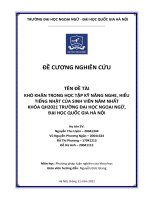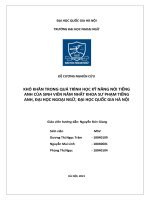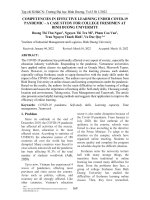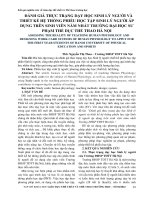Bài phân tích các lỗi thường gặp trong phần viết đoạn văn quan điểm của sinh viên năm nhất không chuyên tiếng Anh đến từ Ulis, vnu
Bạn đang xem bản rút gọn của tài liệu. Xem và tải ngay bản đầy đủ của tài liệu tại đây (400.09 KB, 3 trang )
NGHIÊN CỨU ỨNG DỤNG
AN ANALYSIS OF COMMON ERRORS IN OPINION
PARAGRAPH WRITING MADE DY FIRST-YEAR
ENGLISH NON- MAJORING STUDENTS FROM ULIS, VNU
Bui Th! Hang
*
ABSTRCT
Writing is a productive skill. It is one of the most difficult and therefore frustrating subjects to teach
particularly in an ESL/EFL programme. This paper is an outcome ofteachers ’concerns and efforts to identify
'reas of difficulty’ in writing an academic paragraph among English non-majoring students and to work out
remedial procedures to help them overcome their weaknesses. The study examines 40 opinion paragraphs
about a certain topic ofsecondyear university students. A standardformatforparagraph writing consisting of
10 criteria was usedfor evaluating the types oferrors. Thefrequency of errors was calculated as percentage.
The students’ errors were grouped and analyzed. The study concludes with pedagogical recommendations.
Keywords: Paragraph writing, error and error analysis
Received: 6/1/2022; Accepted: 15/1/2022; Published:16/2/2022
! I. INTRODUCTION
1
.1. Rationale
Writing is always one of the most problematic
skills that challenge every student even in their first
language and are “magnified [...] in a second or
foreign language” (Enginarlar, 1990). In this sense,
it is more difficult to repah the lack of coherence in
writing than in speaking because the opportunity to
asK for clarification or to flashback for background
information in spoken interaction do not exist in
written discourse (Zor, 2006).
In the researcher’s teaching context, coherence is
undoubtedly among the most challenging issues to
cope with in every type of paragraph. This problem is
even more burdening as it comes to opinion paragraphs
whan students are asked to support their ideas with
relevant arguments and logical reasoning. They often
reflect that they cannot provide relevant support that
explains, describes, or exemplifies their ideas, leading
to their failure in achieving coherence in their written
production and negative feedback from the teacher.
The reality mentioned above has inspired the author
to carry out a small research named: “An analysis of
common errors in opinion paragraph writing made by
first-year English non-majoring students from ULIS,
VNU”
1. 2. Aims and research questions
* KhoajTieng Anh, Đại học Ngoại ngừ, Đại học Quốc gia Hà Nội
The study aims to investigate common errors
which ULIS first year students commonly make
in their opinion paragraph writing. Besides, the
researcher would also like to analyze them in the hope
of preventing students from making the same mistakes
over a period of time.
1.3 . Scope of the study
This study focuses mostly on frequently-committed
errors among 40 non-majoring English students from
ULIS in writing an opinion paragraph about a certain
topic. Also, the sample size is limited to 40 entities
only. This small sample size obviously affects the
study results, which, to some extent, reduces the
internal reliability of the research
1. 4. Methodology of the study
To complete the study, the following method is
applied. 40 ULIS students are required to write an
opinion paragraph on a certain topic. On the basis of
given categories of coherence errors, the researcher
can analyze and find out the most common errors
made by those students in opinion paragraph writing.
I L MAIN PARTS
IL L Literature Review
II. 1.1. Opinion paragraph writing
The main focus of this research is expressing
opinions at the paragraph level. Therefore, paragraph
writing or the organization of a paragraph is of
primary importance. Rajatanun (1988:95) said that
a paragraph is a unit of writing which expresses one
!
I
TẠP CHÍ THIẾT BỊ GIÁO DỤC - số 259 KỲ 2 - 2/2022 •
59
II NGHIÊN cứu ỨNG DỤNG
central idea and consists of two kinds of sentences: a
topic sentence and a number of supporting statements.
O'Donnell and Paiva (1993:2-4) provided more
details about the essential parts for paragraph writing
which include a topic sentence, supporting sentences,
details, logical order, logical connectors, a concluding
sentence, unity and coherence. The ideas in the
paragraph must be presented in logical order by using
transition words or connecting words which indicate
the relationship between the ideas (chronological,
causal, etc.). Unity and coherence are also main
components of a paragraph, together with the main
idea and the supporting details. Coherence means
“to stick together.’’ One way to achieve coherence
is with the use of connectors called transition words
or phrases that link one sentence to another (Wyrick
1999:211).
IL J. 2 Errors in Writing
We can conclude that writing is of course, not
easy and in some way, more difficult than speaking
(Noirish 1983:63). Writing is more complex in that
it tests a person’s ability to use a language and the
ability to express ideas. This difficulty of writing leads
students to be more susceptible to producing errors.
This study was designed to identify important features
of students’ errors, the causes of their errors, and
categorize those errors. Errors in language learning,
therefore, play an important role in this study.
Corder (1971 :152) stated that errors are ‘the result
of some failure ofperformance’. Norrish (1983:7), like
Corder, defined ‘an error’ as a systematic deviation
that happens when a learner has not learnt something
and consistently ‘get(s) it wrong’. James (1998:1) also
identified a language error as an unsuccessful bit of
language. Errors are significant in three different ways.
First to the teacher, errors tell him how far the learner
has progressed and, consequently, what remains for
him to learn. Second, errors provide researchers with
evidence on how language is learnt or acquired, what
strategies or procedures the learner are employing
in his discovery of the language. Thirdly, errors are
indispensable to the learner himself, because errors
can be regarded as a device the learner uses in order
to learn. Norrish (1983:21-42) described the causes of
language learners’ errors as arising from carelessness,
interference from the learner’s first language,
translation from the first language, contrastive analysis,
general order of difficulty, overgeneralization,
incomplete application of rules, material-induced
errors and a part of language creativity.
II. 2. Methodology
I1.2.1. Participants
The participants were 40 non-majoring English
students in their second year of study at ULIS,
VNU. They had had little previous English-writing
experience in their secondary and high schools,
since writing is not emphasized at these levels. In
basic writing lessons, the objectives were to develop
students’ writing abilities beyond sentences and also
to familiarize them with various styles of writing, such
as description, narration and argumentation.
II. 2.2. Writing sample and Instrument
Following Halliday and Hassan (1976) who stated
that writing allows writers to demonstrate their ability
to construct a string of well-connected sentences that
are grammatically and logically correct, the students
were asked to state their opinion about studying
abroad. Thus, the writing sample for the study was
40 paragraphs written in English by PPA students.
The ten criteria for analysis were used which are as
follows.
1. Inability to perform the assigned task because of
not understanding the question
2.
No introduction
3.
Lack of main ideas
4.
No topic sentence stating the main points
5. Lack of development of the main ideas (adding
details and facts about the main point)
6.
Lack of organization
7. Accumulation of errors in sentence structure and
/ or usage
8.
No transitional words
9.
Incoherence
10. No conclusion
All the ten criteria were gathered from the survey
and the principles of good paragraph writing from
many books such as TOEFL criteria for correcting
paragraphs (Mahnke & Duffy, 2002), Writing
Academic English (Oshima & Hoque, 2006), Logic,
Language, and Composition (Willis, 1975). The
frequency of errors found in the opinion paragraph
writing of the students was calculated using the
following formula:
Percentage of errors = number of errors (for each
criteria) X 100/total number of subjects (40)
I1.2.3. Data analysis
The analysis of written essays will be derived
from Corder’s (1967) method on error analysis.
This method has three steps: (1) collection of sample
errors, (2) identification of errors and (3) description
60 • TẠP CHÍ THIẾT BỊ GIÁO DỤC - số 259 KỲ 2 - 2/2022
NGHIÊN CỨU ỨNG DỤNG
of errors
II.
ỉ. Results
The following are the results that the researchers
obtained. Errors were found in the writing of most
students. The distribution of type of error was quite
similar for all groups. A high percentage of errors was
found in nine out of ten criteria. The top four criteria
(or causes) of errors were: no transitional words, lack
of organization, lack of main ideas and no conclusion.
(See Table 1)
Order
Criteria Analysis
Level of error
Amount %
1
Inability to perform the assigned 5
task because of not understanding
the question
2
3
4
No introduction
Lack of main ideas
5
Lack of development of the main 30
ideas (adding details and facts
about the main point)
75
6
Lack of organization
35
87,5
7
Accumulation of errors in
sentence structure and / or usage
No transitional words
25
62,5
95
Incoherence
38
24
No conclusion
32
80
8
9
10
No topic sentence stating the
main points
12,5
20
50
33
22
82,5
55
II
Only a small percentage of ULIS first-year English
non-majoring students know how to write a standard
paragraph. Most of them lack the skills of writing a
coherent and well-organized paragraph. They cannot
organize their ideas logically and systematically by
using transitional words. This reflects the need to
improve their ability in English paragraph writing.
Therefore, all ULIS students should be taught to
write a standard opinion paragraph. Furthermore,
transitional words should be taught and emphasized.
These findings will be used as a reference point for
developing materials appropriate to what the students
need. Moreover, the error correction technique to
improve the students’ ability in writing a standard
opinion paragraph should be further investigated
in order to prepare and to develop language skills,
especially English non-majoring students. Given the
results of this study, a number of recommendations for
further research are suggested. First, it is recommended
that further research be undertaken to investigate the
errors made by students majoring in English. Second,
further investigation into intra-lingual errors is
strongly recommended.
REFERENCE
60
II. 4. Discussion
In evaluating the students’ opinion paragraph
writing, the researchers found that most students
cid not present a reasonable connection or relation,
□etween ideas in their paragraphs which causes
“coherence breaks” (Wikborg, 1990). They did not
use transitional words to link the ideas together. Also,
the sentences bin the paragraphs did not directly relate
to the main idea. They only put the content into the
paragraph without expanding on their ideas, so their
paragraphs were short and unclear. They only paid
a tention to content which prevented them from
Ỉriting a detailed paragraph. In addition, it seemed
at most students from ULIS did not have proper
ganizational skills. That is to say their ideas were
rely organized in logical order, which made the
ader find it hard to understand. Also, the participants
paid little attention to supporting ideas. These are the
areas that should be explained to students so that they
keep in mind when writing a paragraph in English.
III. CONCLUSION
Corder, s.p. (1981). Error Analysis and
Interlanguage. Oxford: Oxford
University Press.
Ellis, R. (1995) Understanding Second Language
Acquisition.(10th ed.)
Oxford: Oxford University Press.
Halliday, M.A.K.. & Hasan, R. (1976) Cohension
in English. Landon: Longman
Hart, A.w. & Reinking, J.A. (1990) Writing for
College and Career.(4th ed.)
New York: St. Martin’s Press
Liu, M. & Braine, G. (2005) Cohesive Features in
Argumentative Writing.
Produced by Chinese Undergraduates. System, 33:
623-636.
Mahnke, M.K.& Duffy, B.c. (2002) TOEFL
Preparation Course. New Jersey:
Mackmillan Heinemann.
O’Donnell, T.D. & Paiva, J.L. (1993) Independent
Writing. (2nd ed.)
Massachusetts: Heinle & Heinle Publishers.
Norrish, J. (1983) Language Learners and Their
Errors. London: Macmillan Press.
Reid, J.M. (1994) The Process ofParagraph
TẠP CHÍ THIẾT BỊ GIÁO DỤC - số 259 KỲ 2 - 2/2022.61









